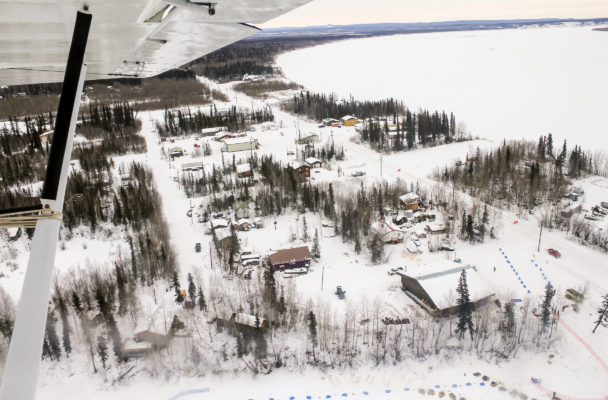
At this point in the Iditarod, just about every top team has declared their mandatory 24-rest, and is either recuperating, or else charging back onto the trail. The rest gives both dogs and mushers a chance to catch their breath and rebuild some strength. And it’s one of the main indicators of a musher’s strategy, finally giving shape to the accelerating race in the days ahead.
All over the dog lot on a frozen slough in Galena, mushers attend to dogs, their headlamps wobbling in the dark like blue lighting bugs. They’re joined by an upbeat Allen Moore, who’s just pulling off the Yukon River:
“Bib number?”
“36.”
“Alright, how many dogs?”
“16.”
“All 16, still, alright. What’s your plan, for staying or going?”
“Oh, I’m staying.”
“You stayin’ for a while?”
“Why not?”
Moore scanned a clipboard to see who’s come in when, joking a little with the race official checking him in.
“You know, I’m thinkin’ long term,” Moore said. “This is a great place, why not?”
“I agree,” the official said.
For Moore, the choice to stop here is motivated mostly by considerations for the dogs on his team.
“Yeah, it’s just a good checkpoint, it’s about 350 miles into the race, I got a couple young dogs that — they don’t know what’s going on, so I just want to get ‘em through it,” Moore said.
Moore was aiming to take his big break here or else one more checkpoint up, in Huslia. With that decision made, he lets go of the break and slides down a small hill to park on the slough.
For other mushers, this is exactly where they aimed to be. Pete Kaiser was set on getting his dogs to Galena for a 24, and didn’t even pack enough food to get to Huslia if he’d changed his mind.
“That’s kind of the idea, they’re still doing fine, but you’ve utilized most of their energy to here, but not all of it,” Kaiser said. “And I think they’re gonna bounce back nice from this rest and keep moving forward.”
Kaiser hasn’t yet taken the eight-hour rest that’s required along the Yukon River. He said he’s waiting to see how his dogs do on the trail in the next few legs. At this point in the race, rest becomes a strategic calculation, both for the energy involved and the potential plans it discloses to other competitors. As mushers think through the next three or four moves they’ll make, many are surveying leaderboards and the GPS tracker to assess who’s resting up, and who’s pushing ahead.
Not everyone’s in Galena because they want to be. Aliy Zirkle’s dogs started showing signs of illness Tuesday, and in spite of her original plan to make it to Huslia, she declared her 24 here instead.
“My dogs aren’t extremely healthy right now, they all have this bug, and a few of ‘em have a fever,” Zirkle said.
Zirkle’s hoping the break, combined with the eight hours she already took not too long before, will still put her dogs in a good position for the nearly 600 miles to go.
Others, like Robert Redington, picked Galena because they found issues with other checkpoints.
“I was gonna do it in Ruby, but I had a bad parking spot, so I came here,” Redington said. “I’m glad I did.”
In the days ahead, mushers will leap frog up and down the leader board as the standings shape up.
Zachariah Hughes reports on city & state politics, arts & culture, drugs, and military affairs in Anchorage and South Central Alaska.
@ZachHughesAK About Zachariah




